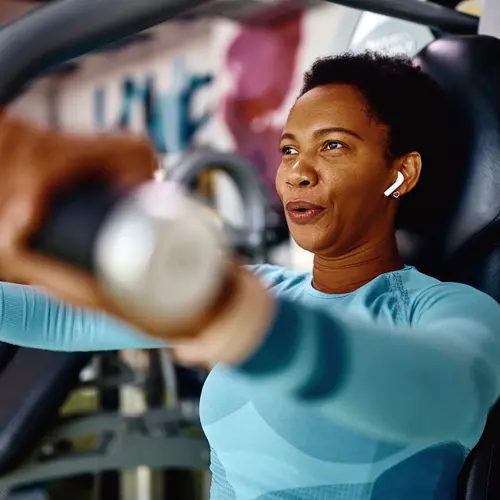Yoga involves many different moves, many of them named after plants or animals. The cobra pose, part of the sun salutation sequence, is one popular yoga move. This pose offers many health benefits to both the mind and body and can easily be incorporated into any yoga routine or done on its own.
What Is a Cobra Pose?
The cobra pose is also called Bhujangasana. This combines two Sanskrit words: Bhujang ("serpent") and asana ("pose"). Like many other yoga poses, it’s named for the animal the pose resembles. In this case, the cobra pose resembles the look of a slowly rising serpent.
The cobra pose is one of 12 moves within the sun salutation sequence, which helps stretch and strengthen the body. The cobra pose helps you open your chest, strengthen your back, and stretch your abdominal muscles.
What Muscles Does Cobra Pose Work?
Cobra pose works to open your chest and strengthen your back. Muscles you use include:
- Pectoral and chest muscles. These help you move your shoulders.
- Pyramidalis. This small, triangle-shaped muscle in your lower pelvis helps maintain proper internal pressure.
- Rectus abdominis. These are the muscles that people refer to when someone has a “six pack.” They stretch vertically from your ribs to the front of your pelvis to help keep your organs in place.
- Transversus abdominis. This pair of deep, flat muscles stabilizes your core.
- External obliques. This pair of muscles on either side of the rectus abdominis allows you to twist your body from side to side.
- Internal obliques. These muscles sit on top of the external obliques and also work to allow you to twist your body.
- Trapezius muscles. These large, triangular muscles form a diamond shape from the base of your neck across to your shoulders. They help with movement, raising your arms, and maintaining good posture.
- Erector spinae. These muscles run the length of your spine and help with breathing and body movement.
How to Do Cobra Pose
Follow the steps below when doing a cobra pose. You can slightly adjust the movement to fit your level of flexibility and fitness.
- Begin by lying on your abdomen on the floor, with your forehead and the tops of your feet resting on the ground or yoga mat.
- Try to keep your feet close enough together for your heels to touch, but no further than hip-width apart.
- Place your palms flat on the ground either underneath or to the sides of your shoulders, whatever is more comfortable. Fingers should be pointing forward.
- Keep your elbows close to your sides.
- Breathe in and gently push up, straightening your elbows as you lift your upper body off the ground. Keep your belly button and pelvis pressed to the floor.
- Draw your shoulder blades back and drop your shoulders away from your ears, keeping your shoulders relaxed. This will open up the chest muscles.
- Keep your neck straight or turn your head toward the sky, depending on your preference and level of flexibility.
- Continue straightening your elbows, pushing your chest higher off the ground. Keep your pelvic bone and thighs pressed into the ground.
- Focus on lifting your chest toward the sky.
- Breathe out to release the move as you lower your body back to the ground.
Cobra Pose Adaptations
The cobra pose is good for beginners. Remember that you don’t have to push yourself past what you can comfortably accomplish. There are several cobra pose variations you can try to accommodate for physical limitations or increase the challenge.
Wall modification. If your flexibility is limited, or if you’re pregnant or have a condition that doesn’t allow you to lie on your abdomen, try a wall cobra pose. Stand with your palms pressed against a wall and your elbows against your sides. Pull your shoulder blades in as you press to open up the chest.
Sphinx pose. This pose is very similar to a cobra pose. However, instead of keeping your palms pressed to the ground and elbows in at your sides, bend your elbows and rest your forearms on the ground in front of you before expanding the chest.
Twisted cobra. This move adds an additional step to stretch the sides of the neck. After you’ve pushed into cobra, turn your neck to the side and gently try to view your opposite heel. Bring your neck back to the front, then repeat on the other side.
If pressing your pelvis into the floor is uncomfortable, try placing a small pillow or cushion between the floor and your pelvic bones.
Cobra Pose Benefits
Cobra pose offers many health benefits. Aside from opening the chest and strengthening the back, cobra pose also:
- Opens the shoulder blades, neck, and collar bones
- Improves spinal posture, flexibility, and alignment
- Reduces back pain
- Improves circulation
- Opens the lungs
- Stimulates the abdominal and digestive organs, improving digestion
- Massages and regulates the adrenal and thyroid glands
- Reduces stress
- May improve sleep quality, fatigue, and symptoms of mild depression
Cobra Pose Mistakes to Avoid
Cobra pose is a relaxed move, but can lead to injury if done incorrectly. Be careful to avoid these cobra pose mistakes:
- Going too fast and stressing your back
- Overextending your elbows
- Moving your neck if you suffer from neck pain
Avoid practicing cobra pose if you are pregnant or have injuries or pain in any of the following areas:
- Wrists, including carpal tunnel syndrome
- Neck (if pain is mild, keep your neck muscles neutral)
- Abdomen, including hernias
- Back, especially the lower back and trapezius muscles
- Ribs

